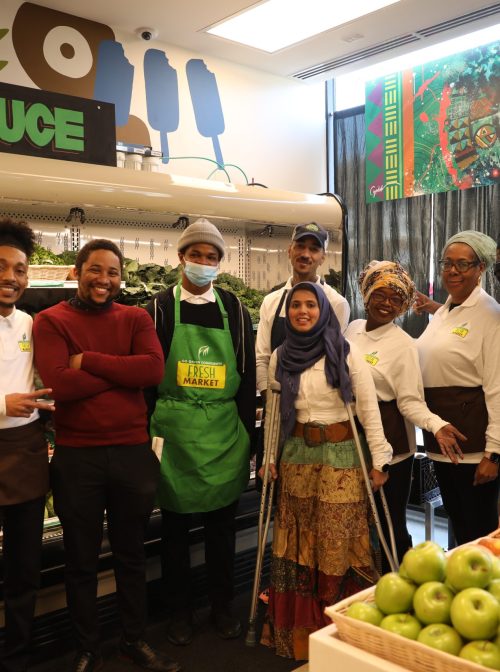“The world better watch out,” Stephanie Coleman, Chicago City Council member, announced to a crowd of shoppers. “Englewood has some good things in store!” March 8, 2023 marked the one-year anniversary of the Go Green Community Fresh Market in the Englewood neighborhood of Chicago.
Inner-City Muslim Action Network (IMAN) established this community hub and grocery store in partnership with other community organizations, to combat food inequity and build bridges within a racially, ethnically, and religiously diverse community. It is the first of its kind on the city’s South Side. A predominantly Black and Brown neighborhood, Englewood residents have been living in a food desert with limited access to healthy foods and fresh produce, where they are often forced to rely on local convenient stores as the primary source of food.
“In the aftermath of the George Floyd protests, businesses started boarding up and moving out of the neighborhood. So, while everyone else was boarded up, we decided to stay and come in at 6 a.m. and start building up,” says IMAN team member Jahari Fultz.
The establishment of the Community Fresh Market and the reinvestment into an under-funded community have significantly impacted the people’s livelihood. Not only has it improved their quality of life, but the Fresh Market also serves as a hub that brings the community together toward a more equitable future.
In an interview with Interfaith America, Sana Syed, the Senior Director of Strategic Initiatives at IMAN, shared the following:
37% of our transactions are made with Electronic Benefits Transfer (EBT), an electronic system that allows a Supplemental Nutrition Assistance Program (SNAP) participant to pay for food using SNAP benefits.
Goods from 20-25 local BIPOC vendors are available in about 3,500 square feet, more than what Whole Foods had in 65,000 square feet!
The second floor of the market has two conference rooms that are typically available for community members to use for their meetings. This allows for more community engagement in a safe space, as the market is in an area that has historically seen a lot of violence.
We prepare our foods and then cool them and sell them from our “grab and go” cooler because that makes it accessible to EBT users, who are not permitted to buy hot prepared food with their benefits. We have a huge demand for that because you have so many single moms, students, and seniors who are not cooking as much or do not have the time to.
This neighborhood has experienced food apartheid where people have not had access to fresh fruits and vegetables and because they have never used them people did not know how to incorporate vegetables into their diet, so we had to provide nutrition education as well.
We thought we would have like 250 members in our reward program. That was our goal. We did not anticipate having 2,800 Members in the first year.

“You can’t be what you can’t see” says IMAN Executive Director, Rami Nashashibi. The goal of the store is to give people something to hold onto by inviting them to be a part of a social fabric that includes and embraces everyone and builds a sense of community in addition to providing affordable and nutritious food.




